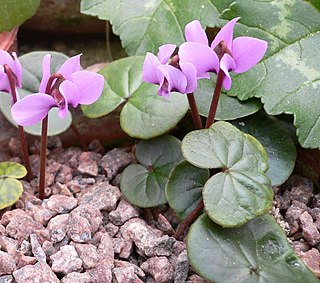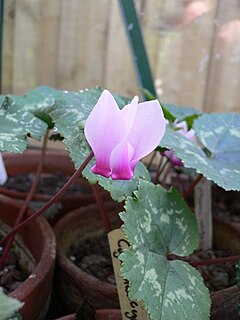
Cyclamen is a genus of 23 species of perennial flowering plants in the family Primulaceae. Cyclamen species are native to Europe and the Mediterranean Basin east to the Caucasus and Iran, with one species in Somalia. They grow from tubers and are valued for their flowers with upswept petals and variably patterned leaves.
A storage organ is a part of a plant specifically modified for storage of energy (generally in the form of carbohydrates) or water. Storage organs often grow underground, where they are better protected from attack by herbivores. Plants that have an underground storage organ are called geophytes in the Raunkiær plant life-form classification system. Storage organs often, but not always, act as perennating organs which enable plants to survive adverse conditions.

Clepsis spectrana, the cyclamen tortrix, cabbage leafroller or straw-colored tortrix, is a moth of the family Tortricidae. It is found in Europe.

Cyclamen hederifolium, the ivy-leaved cyclamen or sowbread, is a species of flowering plant in the family Primulaceae. This widespread cyclamen species is widely cultivated and among the most hardy and vigorous in oceanic climates. It is native to woodland, shrubland, and rocky areas in the Mediterranean region from southern France to western Turkey and on Mediterranean islands, and naturalized farther north in Europe and in the Pacific Northwest.

Cyclamen purpurascens, the Alpine, European or purple cyclamen, is a species of flowering plant in the genus Cyclamen of the family Primulaceae, native to central Europe, northern Italy, and Slovenia. It is an evergreen tuberous perennial with (usually) variegated leaves, and deep pink flowers in summer.

Cyclamen coum, the eastern sowbread, is a species of flowering plant in the family Primulaceae. It is a tuberous herbaceous perennial, growing to 5–8 cm (2–3 in), with rounded heart-shaped leaves and pink shell-shaped flowers with darker coloration at the base. It is valued in horticulture as groundcover, and for the flowers which bloom in winter and early spring.

Cyclamen persicum, the Persian cyclamen, is a species of flowering herbaceous perennial plant growing from a tuber, native to rocky hillsides, shrubland, and woodland up to 1,200 m (3,900 ft) above sea level, from south-central Turkey to Lebanon-Syria and the Palestine region. It also grows in Algeria and Tunisia and on the Greek islands of Rhodes, Karpathos, and Crete, where it may have been introduced by monks. Cultivars of this species are the commonly seen florist's cyclamen.

Cyclamen parviflorum, the small-flowered cyclamen is a perennial growing from a tuber, native to high elevations in the Pontic Mountains of northern Turkey. It is the smallest cyclamen species and the only one native to alpine tundra.

Cyclamen rohlfsianum is a species of perennial plant in the family Primulaceae. It is endemic to Libya. It grows from a tuber in shrubland, especially in limestone cracks, up to 450 m (1,500 ft) above sea level. It is one of the tenderest cyclamen species. The plant was discovered by Friedrich Gerhard Rohlfs in 1879, and was named after him in 1897 by Paul Friedrich August Ascherson.

Cyclamen alpinum is a perennial growing from a tuber, native to pine, juniper, sweetgum, or cedar woodland at 350–1,500 m (1,150–4,920 ft) above sea level in an area of southwestern Turkey, northwest of Antalya, isolated from other species of the Cyclamen coum group.

Cyclamen repandum, the spring sowbread, is a species of flowering plant in the family Primulaceae, native to southern Europe and some Mediterranean islands. It is the most widespread of a group of cyclamens with wide, heart-shaped leaves, often coarsely toothed or lobed, and late spring-blooming flowers with long, slender petals.

Cyclamen africanum is a species of flowering plant in the family Primulaceae. It is referred to by the common name African cyclamen and is a perennial growing from a tuber, native to northern Algeria, Morocco and Tunisia. It is similar to Cyclamen hederifolium, but not frost-hardy.

Cyclamen intaminatum is a perennial flowering plant growing from a tuber, native to oak woodland in scattered spots at 100–1,100 m (330–3,610 ft) in western Turkey. It is similar to Cyclamen cilicium, but smaller.

Nahal Ayun, sometimes spelled Nahal Iyyon, in Arabic: براغيث Bureighit, or in full Nahr Bareighit, is a perennial stream and a tributary of the Jordan River. The stream originates from two springs in the Marjayoun valley in southern Lebanon, runs southward for seven kilometers through various irrigation ditches, then flows into Israel near Metulla, where it continues through the Hula Valley in the Galilee Panhandle until emptying in the Hasbani River just before it reaches the Jordan River.

Cyclamen pseudibericum, the false Iberian cyclamen, is a species of flowering plant in the genus Cyclamen of the family Primulaceae, native to the Amanus or Nur and Anti-Taurus Mountains in southern Turkey. It is an herbaceous, tuberous perennial growing to 12 cm (5 in). It is similar to Cyclamen coum, but with longer petals.

Cyclamen mirabile, sowbread, is a species of flowering plant in the primrose family Primulaceae. A tufted, tuberous herbaceous perennial growing to 10 cm (3.9 in), it is native to Turkish pine woodland and maquis in southwestern Turkey. It belongs to the Cyclamen cilicium group of the genus Cyclamen. The species was identified and named in 1906.

Cyclamen rhodium is a species of flowering plant in genus Cyclamen of the family Primulaceae, native to the Peloponnese, Rhodes, and southwestern Kos. It is a tuberous perennial growing to 10 cm (4 in), with mottled, heart-shaped leaves and pink flowers, darker carmine pink at the base, appearing in spring. Like all cyclamens, the flowers consist of five upswept, reflexed petals.

Cyclamen creticum, commonly known as Cretan sowbread, is a small perennial herb endemic to Crete and Karpathos. It is closely related to Cyclamen repandum, and both are placed in subgenus Psilanthum. Some authorities consider C. creticum to be a subspecies of C. repandum.
Cyclamen (Hungarian:Ciklámen) is a 1916 Hungarian silent film directed by Alexander Korda.
Cyclamen is a genus of 23 species of perennial flowering plants in the family Primulaceae.

















